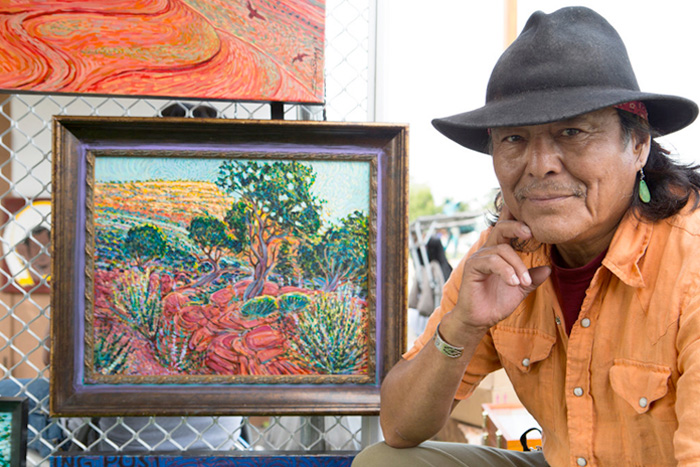
Shonto Begay, a Navajo painter, with one of his works at the Indigenous Fine Art Market. Gabriella Marks for The New York Times.
August 21, 2015
By JOSHUA BROCKMAN
SANTA FE, N.M. — Native American artists converged here this week to sell their work in the Indigenous Fine Art Market, an artist-led initiative that formed last year as an alternative to the Santa Fe Indian Market, produced by the Southwestern Association of Indian Arts.
As the Indigenous Fine Art Market, or IFAM, wraps up Saturday, the Indian Market will be opening for its 94th year. Nearly 950 Native American artists will be at the Indian Market selling their work on Santa Fe Plaza, where throngs of collectors, tourists and museum curators will jockey for position to view and acquire new pieces. The economic effect from Indian Market events totals more than $100 million, according to the city.
The Indigenous Fine Art Market, on the other hand, aims to be a more relaxed marketplace that tries to showcase a broader spectrum of artists who are less defined by classification or competition requirements. Among the nearly 370 artists there on Thursday were Osage, Northwest Coast and Chemehuevi artists from Oklahoma, Alaska and California in addition to a robust showing from the Southwest. The clanging of bells of trains entering and leaving the Santa Fe Railyard, where the market was set up, provided a dramatic backdrop.
“I was blown away that there was representation of the Wampanoag tribe,” David Roche, a senior specialist in American Indian Art for Sotheby’s, said, referring to the diversity of the art works. He had traveled from New York to tour the market for the second year in a row and has attended the Indian Market for the past 25 years. “I think sometimes we forget that at one point there were literally thousands of tribes that were in this country, so to see the diversity and richness of tradition all represented in one place is a special opportunity,” Mr. Roche said.
While both markets are juried shows, IFAM does not award ribbons or prize money, which can be a magnet for collectors and is a big part of the Indian Market’s history as the proving grounds for up-and-coming artists.
Will IFAM, which is run by volunteers, endure?
Dozens of its artists used to show in the Indian Market, but they left after John Torres Nez, a Navajo archaeologist and artist who was affiliated for more than a decade with the Southwestern Association of Indian Arts, or Swaia, resigned as chief operating officer last spring because of differences with the board over how best to handle finances. Months later, a groundswell of artists prompted the formation of IFAM, with Mr. Torres Nez at the helm.
“Everyone buys in,” Mr. Torres Nez said. “Everyone owns it. So I think that makes the atmosphere feel different.”
Kathleen Ash-Milby, a curator at the National Museum of the American Indian in Washington, toured IFAM on Thursday for the first time. “It seems like there’s more of an emphasis on innovation and nontraditional media,” she said. “But it’s still very much in keeping with what Swaia has done.”
Shonto Begay, a Navajo painter, creates landscapes and portraits using dynamic brush strokes reminiscent of van Gogh. He started showing his work at the Indian Market in the 1990s before departing for IFAM. “People have been waiting on the side for a long time trying to get into the Swaia show,” he said. “A lot of them are here.”
Dallin Maybee, a Northern Arapaho-Seneca artist who serves as the chief operating officer for Swaia, said only about 55 percent of artists who apply are accepted into the Indian Market.
As for the talent at IFAM, museum curators have already found it to be a rich resource. Ann Marshall, the director of curation and education at the Heard Museum in Phoenix, met Tom Farris, an artist of Otoe-Missouria and Cherokee descent, at last year’s market.
“He had on exhibit the big painting of Superman as a Cherokee superhero, and that was something that immediately caught my attention,” she said. The Heard bought the painting, “(Su)perman,” for its “Superheroes” show, closing Monday.
He is among about a dozen artists who hedge their bets by showing in both markets. “I like the idea that since we have to be out here anyway to enter pieces for judging for Swaia we might as well make some money and do another market,” Mr. Farris said. On Friday, he received a creativity award for a war club in the diverse arts category.
The Assiniboine-Sioux artists Joyce Growing Thunder and her daughter Juanita Growing Thunder Fogarty, who are sharing a booth at the Indian Market, are celebrating their 30th year in attendance. They’re known for putting a contemporary spin on traditional beadwork, quillwork and dolls. Camryn Growing Thunder, 12, Juanita’s daughter, is part of the third generation of their family now participating. She won the best in class for youth for her painted parfleche purse.
Juanita Growing Thunder Fogarty said the Indian Market remains a singular experience: “This is the only market we do. This is it because of the amount of the time that goes into our work.” After the Indian Market is over, the cycle will continue. They will immediately start work on new projects.
Mr. Torres Nez and his team also have plans: They expect to expand IFAM to tribes, pueblos and other cities.
Read original article, which appeared on Page C3 of the New York edition.
© The New York Times Company
